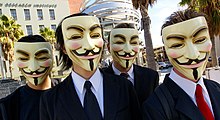Fictional resistance movements and groups
Appearance
This article needs additional citations for verification. (December 2021) |

Fictional resistance movements and groups commonly appear in dystopian fiction, opposing tyranny.
Literature
[edit]In Chuck Palahniuk's Fight Club, the tyranny is the soul-destroying life of modern western society. The protagonist rebels against this by organising atavistic bare-knuckle fights and then by leading Project Mayhem to destroy civilization. This story developed themes of alienation and anti-consumerism seen in earlier works such as Rebel without a Cause and The Prisoner.[2]
List of fictional resistance movements
[edit]- Alice — An ex-employee of the Umbrella Corporation turned anti-Umbrella fighter willing to take down and destroy the evil megacorporation responsible for the Global T-Virus outbreak in Resident Evil.
- Alliance to Restore the Republic — In the Star Wars original trilogy, the Alliance to Restore the Republic, more commonly known as Rebel Alliance; is a military force that wishes to depose Emperor Palpatine and restore the Republic.
- Blake's 7 — rebels against the Terran Federation in Blake's 7.
- The Brotherhood — the opposition to The Party in George Orwell's Nineteen-Eighty Four.
- Chaos Insurgency — a splinter group of the SCP Foundation, created by a rogue task force that went A.W.O.L. with several SCP objects in 1924 and has been fighting the Foundation since.[3]
- Maquis — resistance to the Cardassians in Star Trek.
- The Mephi — rebels getting ready to revolt against OneState in We by Evgeny Zamyatin.
- Merry Men — mythical English band of outlaws led by Robin Hood opposed to the Sheriff of Nottingham in English folklore.
- The Order of the Phoenix, Dumbledore's Army – underground resistance to Voldemort and his Death Eaters in Harry Potter and the Deathly Hallows by J. K. Rowling.
- Pulang Araw,Vendetta,Task Force Agila-a trio of resistance movements under the leadership of Cardo Dalisay, President Oscar Hidalgo, and Romulo Dumagit in opposition to drug and business syndicate leaders, corrupt and greedy politicians and tycoons, power-hungry and avaricious elites, murderous terrorists and warlords,even unscrupulous and wicked policemen responsible for putting the Philippines under their despotic and totalitarian rule in FPJ's Ang Probinsyano.
- La Résistance — movement of the children of South Park, Colorado opposing the United States' war against Canada as instigated by Mothers Against Canada in South Park: Bigger, Longer & Uncut.
- The Resistance — network of humans and vortigaunts fighting the Combine in Half-Life 2.
- The Resistance — the military force that wishes to depose the Supreme Leader and restore the New Republic in the Star Wars sequel trilogy.
- Song Jiang — leader of outlaws during the Song dynasty and fictionalized in the Water Margin.
- Wartwood Resistance — A movement of the residents of Wartwood Swamp, led by Sasha Waybright, Captain Grime and later Anne Boonchuy, to depose the tyrannical King Andrias in the third season of Amphibia.
See also
[edit]References
[edit]- ^ Emily McAvan (2012), The Postmodern Sacred: Popular Culture Spirituality in the Science Fiction, Fantasy and Urban Fantasy Genres, p. 163, ISBN 9780786492824,
as with the use of the iconic Guy Fawkes mask from the Wachowskis' V For Vendetta as a symbol of anonymous resistance at protests
- ^ John M. Stoup, Glenn W. Shuck (2007), "God's Unwanted: Fight Club and the Myth of "Total Revolution"", Escape Into the Future: Cultural Pessimism and Its Religious Dimension in Contemporary American Popular Culture, Baylor University Press
- ^ TwistedGears (6 July 2014). "Chaos Insurgency Hub". SCP Foundation Wiki. Retrieved 28 October 2021.
Further reading
[edit]- Junius P. Rodriguez (2007), Encyclopedia of Slave Resistance and Rebellion, Greenwood Publishing Group, ISBN 9780313332722
